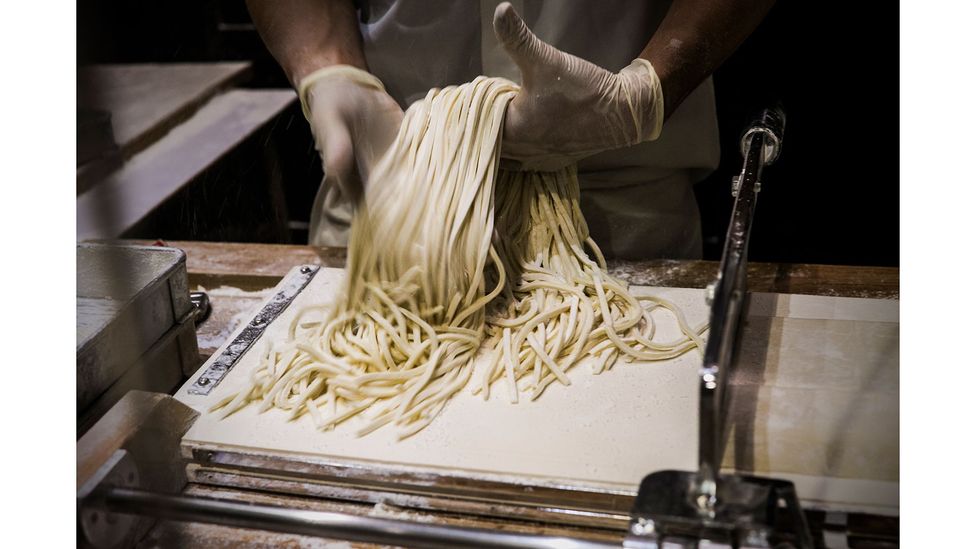A noodle is a delicate thing. Shinji Sasaki would be the first to tell you. Too porous, and it will get soggy. Too dense, and it won't cook evenly. Behind all the noodles you toss into a boiling pot of water, there's probably a team of food scientists like him, employed by the manufacturer to calculate the precise ingredients and chemistry required to achieve the desired effect.
And Sasaki has another tricky layer or two to work with: as a food scientist at Ajinomoto Foods, he is one of the people behind an unusual processed food that can be found lining grocery freezer shelves. These are frozen ramen bowls, ready for the office microwave. When noodles have to be cooked, frozen, and then microwaved, the bar is set very high for the scientists hoping to make a quick ramen lunch palatable.
Instant ramen, of course, has a beloved place in many hearts. The comforting bounce of noodles that have been fried and dried and rehydrated, the bite of the salty soup packets, the swift transformation from brittle puck to savory snack – what's not to like? It doesn't have very much in common with ramen made fresh in a shop, though. And as American palates learned what these noodles could be like in recent years, following a groundswell of ramen shop openings, the company began to ponder producing something closer to the fresh version, recounts Taro Komura, an executive vice president at Ajinomoto Foods North America.
Ajinomoto, by the way, was founded in 1908 by a Japanese chemist who discovered certain molecules behind the flavour called umami and gave it its name – he started the company to sell monosodium glutamate, a tasty new seasoning.

Instant dried noodles are made in such a way that means they are porous and quickly soak up water (Credit: Wachiwit/Getty Images)
Because instant ramen has to cook swiftly when the hot water is poured over it, the noodles are designed with plenty of space within each strand. "The internal structure of the instant noodle is porous," Sasaki says, so that water can rush in and saturate it quickly. From the perspective of Ajinomoto and its goal of delivering a better ramen, the best way to get a fresh-tasting noodle to the customer was to cook it, then freeze it. That required a technically different approach from instant noodles. Porous noodles don't age well, as anyone who's forgotten a cup of noodles in the microwave can relate.
An added danger to the noodles' integrity, Sasaki adds, is that while Japanese eaters slurp piping-hot noodles very quickly, not everyone is so fast. Sitting in the soup is a problem.
You might also like:
- The comfort food that took over the world
- How processed foods became unhealthy
- The food that could last 2,000 years
- Is it safe to microwave food?
So, he and his colleagues aimed for a noodle that was the opposite of the instant version – one that was very dense. The process that they developed starts with a fairly standard ramen dough. But then the dough is run through a series of rollers covered in grooves, which press the air bubbles out of the dough as if they were toothpaste in a tube. The rollers also produce a fine, smooth texture on the dough sheet – the scientists checked it using a microscope.
That smooth surface makes it more difficult for water to penetrate the noodle's structure. Stacking three of these sheets atop each other, then rolling them out leads to noodles that are significantly denser than normal ramen. They can stand up to being cooked twice: once in the factory, where they are cooked, arranged into little nests with seasonings and toppings, packaged up, and frozen, and once in the microwave, where four minutes gives the office dweller a hot bowl of noodles.
The engineering required to produce this effect is far from minimal. The pooled expertise of an entire team of food scientists, people who've spent decades getting to know the inside of a noodle, from the molecule upwards, went into that frozen package. (In fact, Ajinomoto has patented the roller system.)
The seasonings, that other distinctive feature of the ramen, are likewise complex. But in a way, freezing simplifies the team's goal.
Ramen soup is traditionally made of two components: a broth using seaweed, dried mushrooms, fish, or meat, and a pungently salty flavouring, like miso or soy sauce.
"When building flavour during the cooking process, there's a scientific reason why certain combinations and pairings in ramen taste so delicious," says Sasaki. "When you combine kombu [seaweed] or MSG, which contain glutamate, plus meat, which contains inosinate, and dried shitake mushrooms, which contain guanylate, each part interacts with each other to intensify the flavour. Umami is enhanced by synergistic interactions of glutamate with (the) nucleotides inosinate and guanylate." (Read more about the science of umami in an earlier column here.)

The way the dough is layered and prepared beforehand can help to determine how well the noodles cope with being frozen (Credit: Getty Images)
In instant ramen, some of that depth is lost because when the seasonings are dried, aromatic components can become volatile and float away. Frozen is a different story, however. More of what's lovely about a fresh restaurant ramen broth survives, Sasaki says, because freezing does not lead to the same disruptions.
Ajinomoto's founder's discovery, MSG, is a common ramen shop ingredient in Japan. It gets a bad rap in other parts of the world, but studies have failed to find evidence of any danger – the initial 1980s MSG scare can be traced back to a speculation in a New England Journal of Medicine letter that has not been borne out by later work. In the quest to make quick ramen taste like the real thing, MSG would be a nice thing to be able to use, Komura says. As yet, it's still persona non grata in the US — but a company can dream.
--
Join one million Future fans by liking us on Facebook, or follow us on Twitter or Instagram.
If you liked this story, sign up for the weekly bbc.com features newsletter, called "The Essential List". A handpicked selection of stories from BBC Future, Culture, Worklife, Travel and Reel delivered to your inbox every Friday.
"behind" - Google News
September 08, 2021 at 07:04AM
https://ift.tt/2X1oC2I
The clever science behind frozen ramen - BBC News
"behind" - Google News
https://ift.tt/2YqUhZP
https://ift.tt/2yko4c8
Bagikan Berita Ini














0 Response to "The clever science behind frozen ramen - BBC News"
Post a Comment